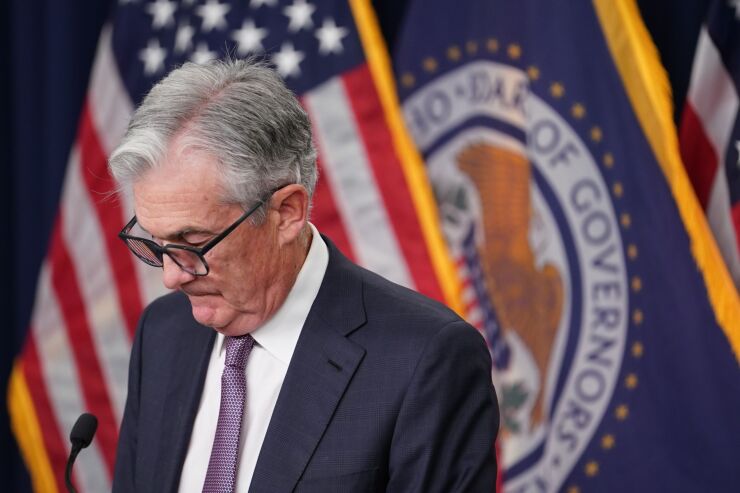The Federal Reserve's balance sheet runoff is picking up steam after its monthly cap on unreplaced maturities doubled to $95 billion last month. Last week alone, it shed $37 billion of assets.
As the central bank ramps up its effort to
The Fed has been steadfast in its commitment to tightening monetary policy until inflation abates, but it remains unclear if it can avoid a repeat of the September 2019 tightening cycle, when a scarcity of reserves forced the Fed to expand its balance sheet again. The threat is punctuated by last month's U.K. government debt crisis that forced the Bank of England to intervene in the bond market to avoid a financial catastrophe.

"The trick is to keep banks safe while making no changes to balance sheet runoff unless inflation risks ease enough to allow a monetary policy shift," Derek Tang, co-founder of the Washington-based research firm Monetary Policy Analytics, said. "After all, the whole point of balance sheet tightening, along with rate hikes, is to make lending more costly."
When the Fed reduces assets, such as Treasury and mortgage-backed securities — both of which it bought in large volumes to support the U.S. economy through the COVID-19 pandemic — it also reduces its liabilities. The bulk of the Fed's liabilities are deposits from member banks.
Also known as reserves, these deposits are used by banks to protect themselves against losses and runs. They are also a preferred source of liquidity that can facilitate lending during periods of economic distress and to fund resolution plans should a bank fail.
The last Fed tightening cycle, which began in 2015, was cut short by a
After that episode, the Fed created a new mechanism for providing liquidity known as the standing repurchase agreement facility. But since its debut in July 2021, only 14 institutions have signed up to be counterparties. Bill Nelson, executive vice president and chief economist at the Bank Policy Institute, said the limited participation is tied to a belief among banks that doing so would be viewed in the same light as using the Fed's discount window.
"Unfortunately, the Fed has not yet stated — as far as I know — that banks can plan on using the standing repo facility as a way to monetize their assets," Nelson said. "It's extraordinary, because the Fed has created this facility and they've made it clear that they intend for this to be something they don't want a stigma associated with. They want banks to feel free to use it. But banks can't plan on using it."
Reserves in the Fed system have fallen from their peak of $4.2 trillion at the end of last year to a little more than $3 trillion as of last week. The Fed's balance sheet reduction, which was capped at $30 billion of Treasuries and $17.5 billion of MBS from June through August, contributed to this decline, but it was not the sole driver. The Fed's overall balance sheet has only declined about half a trillion dollars during that time. The rest of the reserve decline has been fueled by increases in other Fed liabilities, such as Treasury issuances and repurchase agreements.
Normally, the Fed requires banks to hold a certain percentage of the deposits they take in from their customers as reserves, but that requirement has been suspended since the onset of the pandemic. When that will be resumed and what level is one of many pending regulatory questions that could influence the demand for reserves moving forward.
Another looming change is to the supplementary leverage ratio. Between March 2020 and March 2021, the Fed exempted reserves and Treasuries from the calculation for the capital requirement, effectively freeing up more investable capital for banks. Fed Vice Chair for Supervision Michael Barr has promised to
"The SLR was written as if reserve balances would go back to a pre-2008 scarcity regime," Tang said. "The staff had to write it this way because the FOMC did not officially switch to an ample-reserves model until 2019. If reserves and Treasuries are exempted, it would help the financial system weather changes in the funding environment … with the intermediation of Treasury securities."
As the Fed attempts to balance its monetary objectives with its regulatory duties and broader financial stability, bank advocates are urging the central bank to rethink its approaches to reserve management and liquidity planning.
Nelson penned a white paper last month calling for the Fed to abandon its policy for maintaining "ample reserves," in which it aims to keep slightly more reserves on its balance sheets than the market deems necessary.

Nelson argued that because of the supervisory pressure to hold onto reserves, banks will always adjust their demand to meet the current level of supply.
"The more reserves they provide, the more banks need," he said. "If they're providing $300 billion more than what banks need, then banks' needs will grow and then they'll need to keep providing more."
Nelson added that the Fed should also make it easier for banks to capitalize themselves with assets, such as Treasury securities and agency MBS, and to incorporate the use of repurchase facilities into their liquidity plans. While neither practice is prohibited, Nelson said they are strongly discouraged by bank examiners.
Some policy experts see different reasons for banks' gravitating toward reserves. Dennis Kelleher, head of the Washington-based advocacy group Better Markets, said bank examiners do not have a preference about how banks capitalize themselves, but they do encourage banks to be realistic with their forecasts.
Much like their British counterparts, U.S. Treasuries are subject to market volatility, Kelleher said, which is likely to be present in a stress scenario that would cause a bank to need emergency liquidity. Reserves, meanwhile, are simple cash in a reserve bank account, so they will hold their value.
"The Bank Policy Institute
In his paper, Nelson encourages the Fed to consider a reserve system more akin to the Bank of England, which keeps its reserve levels just below what the level of market demand. To offset this scarcity, it is more accepting of banks using repurchase agreements and other credit facilities to bridge their gaps. He said this presents a more viable path to returning the Fed's balance sheet to its pre-COVID volume, as the Fed has said it would like to do.
"Because market rates will be a bit above what the central bank is paying for reserves, banks will economize reserves, supervisors will be used to banks finding different ways to satisfy their liquidity needs and that process over time will generate a smaller central bank, not a larger central bank," Nelson said. "Also, it's a process under which borrowing becomes more frequent and, effectively, the only way for the stigma associated with borrowing from the central bank to be eliminated, is for borrowing to become ordinary."





